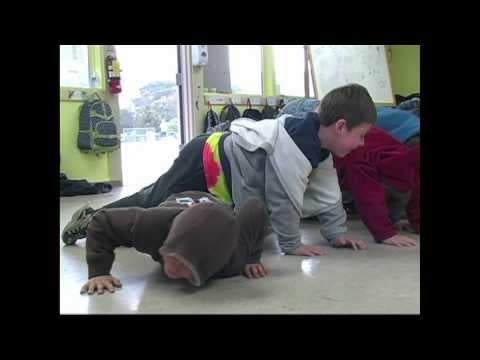Healthy Active Play Environments
Case Study: Fun Options to Promote Physical Activity Make Kids “HAPE”
The Healthy Active Play Environments (HAPE, pronounced “happy”) program helped create healthy afterschool environments throughout San Mateo County in 2012 and 2013. In these workshops, after school program staff learned how to provide structured, fun, inclusive, and non-competitive physical activities for kids.
Having worked with youth since 1996, Adrian Padilla was asked to serve as the Director of HAPE after he was observed leading “games” focused on physical activity with over 50 kids in his role as Physical Education Specialist with Footsteps Childcare Inc. Part of his new role with HAPE was to train after school providers to offer similar activities and manage large groups of children who may not be used to active play.
The goal of HAPE was both to teach staff how to engage children and offer more structured physical activity during the afterschool program day and also to turn the staff into ambassadors, through a train-the-trainer component, who would continue promoting physical activity once Mr. Padilla is no longer there. “The kids want to and enjoy participating in structured activities, especially ones who don’t do sports or don’t excel in school,” says Mr. Padilla.
“Success and how they [children] see themselves, connects to self-esteem, self-image, and feeling worthy and confident, and they take this with them through their life.” -Adrian Padilla, HAPE Director
A challenge has been monitoring the quality of the implementation by afterschool program staff and in particular the application of the state guidelines for afterschool physical activity, a core component of what Mr. Padilla teaches staff. To continue supporting the staff after they had completed the HAPE workshops, Mr. Padilla would call to check in, but it was difficult to ascertain the level to which these practices were being implemented.
10 California After School Physical Activity Guidelines (2009)
- Create an after school physical activity culture that fosters youth development
- Develop and implement after school physical activity policies
- Plan and evaluate after school physical activity
- Build and maintain a strong infrastructure for after school physical activity
- Ensure that all directors and staff members support and promote after school physical activity programs
- Develop and maintain high-quality after school physical activity
- Ensure that all students achieve the appropriate amounts of physical activity after school
- Ensure that all students are included in after school physical activity
- Connect after school physical activity with the regular school day
- Build partnerships with the community to support after school physical activity
Encouraging Long-Term Healthy Habits
For Mr. Padilla, engaging youth in physical activity is vital to a healthy community because of the applications it brings to their everyday life and to establishing long-term healthy life habits. Through his workshops, he aimed to create activities that would foster success, and used an “if it’s too easy, trick them into confidence” approach by including activities students may not expect to succeed in but then do.
The fun physical activities were often also supported by the introduction to healthy lifestyle choices. The children, “may not even realize that they are doing vigorous activity and learning long-term healthy habits,” said Mr. Padilla.
Measuring Success
Success of the HAPE was measured through written evaluations given to workshop attendees and program directors, and verbal evaluations from students. Mr. Padilla took the feedback into consideration as he planned future trainings. He has since adjusted some games and activities that were thought to not age-appropriate for a given group. Some staff have more experience working with certain age groups, and were able to provide valuable feedback on which activities to offer.
Future Implementation of HAPE
Get Healthy funding is designed to be seed money for pilot projects. Even though Mr. Padilla received calls from programs in Silicon Valley, Santa Clara, and Palo Alto who are interested in what he does, it was difficult to identify funding outside of San Mateo County to continue the workshops. Other Counties simply do not have the funding although “the value is recognized,” he says.
One thing Mr. Padilla would do differently if given the opportunity is start after school program at the preschool level. Mr. Padilla hopes to bring his brand of physical activity to younger children in hopes it will change the dynamics of recess and free time among the preschool age.
This very successful partnership between Mr. Padilla and Footsteps Inc., who managed the program, allowed Mr. Padilla to focus on implementing the project with the passion and enthusiasm that has been repeatedly shown throughout the life of his project. Mr. Padilla has wondered before if he should branch off and grow a one-man team as a private project. The idea is not off the table, yet he feels the most effective way to keep healthy activity present and going is to do these on-sites where teachers can “see enthusiasm…transfer from exercises to games…” among groups of 50-60 children who are not only present, but effectively managed.
About Get Healthy Implementation Funding
Each year, Get Healthy awards a total of $100,000 – $150,000 in funding to community and faith-based organizations, nonprofits, cities, and schools in San Mateo County for place-based primary prevention and health equity efforts and projects. The focus of this program is to create long-lasting policy level and environmental change to the food and physical environment where we live, work, play, and go to school and help make the “healthy choice the easy choice” for everyone in the San Mateo County.


